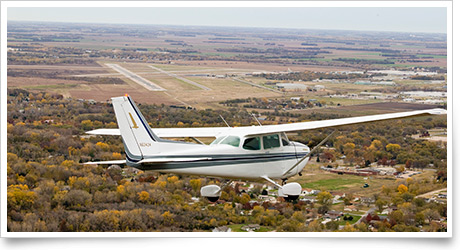Custom content for the Feb. 15, 2013, issue of 'AOPA ePilot' newsletter
training tipsBase-leg basics
Where and when you start the turn to the base leg will do much to determine whether what follows is a stable, orderly arrival in the touchdown zone, or a series of attempts to correct errors, possibly resulting in a balked landing.
“The placement of the base leg is one of the more important judgments made by the pilot in any landing approach,” notes Chapter 7 of the Airplane Flying Handbook. “The pilot must accurately judge the altitude and distance from which a gradual descent will result in landing at the desired spot. The distance will depend on the altitude of the base leg, the effect of wind, and the amount of wing flaps used.”
Landing your trainer in a strong headwind, you should turn base closer to the runway than you would on a calmer day. But if performing a no-flap landing, you would position the base leg at a greater distance than in a flaps-extended configuration. That would allow for the shallower glide path your trainer would deliver in the low-drag flapless configuration.
Flaps or not, making a first landing at an unfamiliar destination airport has the useful effect of getting you out of your comfort zone, reminding you of the multiple decisions that go into flying a traffic pattern. Absent the now-familiar landmarks of the home airport, and likely approaching a runway of a different length, width, bearing, and even possibly a different surface, you must revert to reliance on your hard-earned basic skills.
Remember that if a crosswind landing awaits you, groundspeed on the base leg will be affected by a headwind or tailwind component. If it’s a tailwind, start your turn to final early enough to avoid flying beyond the extended runway centerline.
How did it go? If this cross-country flight has also served as a refresher on traffic pattern operations, it may pay immediate dividends when you fly the pattern back at the home field.
See if your fresh perspective sharpens your performance when you land on that most familiar of all runways. training productsAviation headset manufacturer Lightspeed Aviation has released FlightLink 1.2, an upgrade to its free app that turns iPads, iPhones, and iPod Touches into cockpit voice recorders. The new version includes a file compression feature that makes audio files both smaller and compatible with a wider variety of audio management software. FlightLink 1.2 is available at Apple’s App Store and is compatible with newer Zulu.2 headsets. Older Zulu.2 headsets can be factory retrofitted for a nominal fee.
TagPilotSupply.com has dropped the price on the Cirrus Private Pilot Training Kit, from $349.99 to $295. The kit, created by ASA, is a comprehensive student pilot ground school kit, preparing for the private pilot certificate with an instrument rating.
Note: Products listed have not been evaluated by ePilot editors unless otherwise noted. AOPA assumes no responsibility for products or services listed or for claims or actions by manufacturers or vendors. final examQuestion: I’m a student pilot and am about to go on my first cross-country. I plan on getting flight following, but am nervous about how fast the controllers talk and don’t want to mess up. What does the FAA suggest I do to cue them to slow down and help me out a little if I sound like I’m stumbling or confused?
Answer: AIM 4-2-4 (c) spells out the FAA’s desire to help student pilots gain sufficient practical experience in an environment where they will be required to operate proficiently in the future. The FAA recommends getting additional assistance while operating in areas of concentrated air traffic. This is very easy—on initial call to an air traffic control facility, or to a new controller, the student pilot should include the words “student pilot.” For example, “Dayton Tower, Skyhawk One Two Three Four, student pilot.” This special identification will alert FAA personnel and enable them to provide student pilots with such extra assistance and consideration they may need. It is recommended that student pilots identify themselves as such, on initial contact with each clearance delivery prior to taxiing, ground control, tower, approach, and departure control frequency, or FSS contact. Also, if it’s a busy air route traffic control center, it may not be a bad idea to mention you’re a student pilot with them as well.
Got a question for our technical services staff? Email [email protected] or call the Pilot Information Center, 800/872-2672. Don’t forget the online archive of “Final Exam” questions and answers, searchable by keyword or topic. |
 You determined the proper direction for landing at your cross-country destination airport, have descended to traffic pattern altitude as described in the
You determined the proper direction for landing at your cross-country destination airport, have descended to traffic pattern altitude as described in the 

